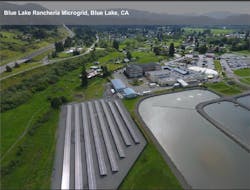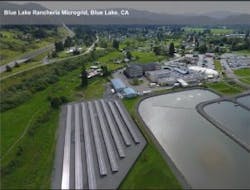California Bill Would Make it Easier to Develop Clean Energy Microgrids; Nixes Fossil Fuels
California lawmakers are considering a bill that would make it easier to develop clean energy microgrids and prohibit those that use certain fossil fuels.
Blue Lake Rancheria, a low-carbon microgrid in Humboldt County, California. Courtesy of Siemens
Now in the Assembly Appropriations Committee, Senate Bill 1339 passed the Senate in a 29-8 vote in late May and underwent revision in committee July 5.
The legislation would prohibit utilities from issuing permits for any microgrids that use diesel backup or gas combustion, while boosting clean energy microgrids via utility tariffs and streamlined interconnection and permitting.
Sponsored by Sen. Henry Stern, a Democrat, the latest version of the bill specifically calls upon the California Public Utilities Commission (PUC) to work with the California Energy Commission (CEC) and the California Independent System Operator (CAISO) to take a series of actions by Jan. 1, 2020. These include:
- Develop rates and tariffs, as necessary, to support microgrids
- Develop microgrid service standards necessary to meet state and local permitting requirements
- Without shifting costs to ratepayers, develop methods to reduce cost barriers for microgrid interconnection requirement
- Develop guidelines that determine what impact studies are required for microgrids to connect to the grid
- Form a working group to codify standards and protocols needed to meet California electrical corporation and CAISO microgrid requirements
- Develop a standard for direct current metering to streamline the interconnection process and lower interconnection costs for direct current microgrid applications
An earlier version of the bill also required that utilities account for the operational and societal benefits of microgrids generally and ratepayer benefits specifically. But the language was struck in the recent revisions.
Language in the bill states that “many electricity customers are seeing the potential benefits of investing in their own distributed energy resources as part of microgrids, both to ensure their own level of reliability and to better manage their own usage.”
The clean energy microgrid bill is part of a larger government effort to help commercialize the technology in the state. For example, the CEC is developing a roadmap that will offer a series of actions to accelerate adoption of the microgrids. In addition, the CEC earlier this year awarded about $50 million to ten projects that participated in a competitive grant competition.
Track news about clean energy microgrids. Subscribe to the free Microgrid Knowledge newsletter.
About the Author
Elisa Wood
Editor-in-Chief
Elisa Wood is the editor and founder of EnergyChangemakers.com. She is co-founder and former editor of Microgrid Knowledge.

